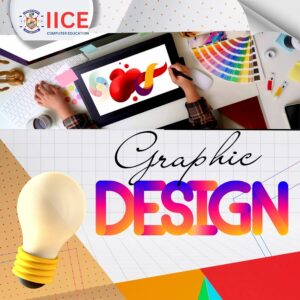
Graphic Designing course

Work and Job Scopes of Graphic Designing Course
The Graphic Designing course teaches students to create visual communications, combining creativity and technical skills. Students learn to design logos, brochures, posters, and digital graphics using industry-standard software like Adobe Photoshop and Illustrator. Graduates can work as graphic designers, art directors, creative directors, or start their own design studios.
Job opportunities exist in advertising agencies, publishing houses, branding firms, and digital media companies. With the rise of digital media, the demand for skilled graphic designers is increasing, offering excellent job prospects, competitive salaries, and opportunities for freelancing and entrepreneurship in various creative fields.

Graphic Designing course syllabus
Introduction to Graphic Design
- Overview of Graphic Design
- The role of a graphic designer
- History and evolution of graphic design
- Types of graphic design (print, digital, motion, etc.)
Color Theory
- The color wheel and color harmony
- Primary, secondary, and tertiary colors
- Color psychology and its impact on design
- Using colors effectively in design projects
Typography
- Introduction to typography
- Types of fonts: Serif, sans-serif, script, display fonts
- Font pairing and hierarchy
- Typefaces and their usage
- Designing with typography for readability and impact
Adobe Photoshop
- Introduction to Photoshop tools and interface
- Working with layers, masks, and filters
- Image manipulation, retouching, and photo editing
- Creating and editing raster graphics
Adobe Illustrator
- Introduction to vector-based design
- Working with paths, shapes, and curves
- Creating logos, illustrations, and icons
- Color theory and fills for vector designs
- Advanced illustration techniques
CorelDRAW
- Overview of CorelDRAW tools and interface
- Creating vector illustrations and logos
- Working with advanced shapes, paths, and color fills
- Design and layout techniques using CorelDRAW
- Preparing designs for print and digital use
About Graphic Designing Course
A Graphic Designing Course is best learning, meant to provide students with rich knowledge art and science used in creating visually beautiful visual content. Among the domains of practice related to visual communication are advertising, marketing, branding, publishing, and multimedia, to name but a few that this course helps the students be able to contribute towards. You are a creative person and may need to design logos, create advertisements, build brochures, design a website, or create social media graphics. If so, this is the right Graphic Designing Course to explore your creative side through practical technical knowledge.
The demand for professionally qualified graphic designers has increased multifold in today’s digital era, where companies wish to build long-lasting brand images, promote their products innovatively, and visually appeal to their target groups. A Graphic Designing Course will guide the student into a rewarding career by merging creativity with technical knowledge. The student will acquire industry-standard design tools like Adobe Photoshop, Illustrator, InDesign, and other specialized software tools that are required to produce professional designs.
Why to study graphic designing course?
Graphic designing course has become the need of the hour for modern communication. Every company and organization in this world hires a graphic designer to create content that presents its ideas to the targeted audience in a visually attractive way. Digital, print media, and advertising require tremendous visual content for effective reach towards the targeted audience. The pursuit of a Graphic Designing Course enables students to produce skills that meet the markets and are ready to thrive in this ever-changing business field.
Another reason to opt for a Graphic Designing Course would be the acquisition of both artistry and technical skills. A graphic designer combines all his or her artistic and scientific knowledge about color theory, typography, layout, and visual hierarchy to work out working designs.
They are also competent and aware of handling other applications; for instance Adobe Creative Suite that is a certificate that the school should receive ahead of time by when that sort of design actually becomes functional. From base level skills up through each individual application, starting with print then internet to apps and mobile a graduate can exit school fully trained and certified. This further exposes the student to the industry where they gain very adaptable skills.
Structure for Graphic Designing course
A Course in Graphic Designing course usually spans a few months to a year. It could either be an on-campus course or an online one. This syllabus usually involves theory as well as practical classes. Given below is the list of important subjects included in the Course in Graphic Designing:
- Introduction to Graphic Design
Basic principles, elements, and history of graphic design. Evolution of graphics as applied to communication; Design disciplines. A definition and overview for a broad categories like branding advertising web and Print.
2. Theory and principles in graphic Design
Overview of basic design principles; elements include balance contrast, alignment proximity; Visual hierarchy: how it impacts user perception and engagement.Grids, layouts, and spacing: how to make designs balanced.
- Typography
Introduction to typography, a font family, and typefaces.Principles of typography: leading, and line spacing.How to create text that works well both visually and as copy in any design.Typography in web and print design, and its role in branding and user experience.
4. Color theory
5. Adobe Photoshop
6. Adobe Illustrator
Learn about vector graphics designing course and why these are important in scalable designsMaster the tools in Adobe Illustrator for logos, icons, and illustrations among other vector-based artworks.Master the tools, effects, and techniques in Illustrator to work with complex shapes, paths, colors, gradientstoward creating detailed designs,Both print and digital media-friendly vector illustrations
7. InDesign for Layout Design
Introduce Adobe InDesign as a tool for creating a multi-page layoutBrochures, magazines, newsletters and book designGridded work, templates, and formatting text for a pro document;Print vs. digital layout design.
8.Foundations of Web Design and UI/UX Principles
Introduction to basic concepts of web design, which places importance on responsive design, but will really have the learners “think.” Discuss how to understand differences in between User Interface vs. User Experience designs and have a brief exploration on utilizing Adobe XD, and Figma in the crafting of and wireframing and mocking.Discuss the best way to make an aesthetically pleasing website that functions in the finest manner with respect to applications.
- Branding and Identity Design
Understanding the elements of a brand identity: logos, color palettes, and fontsHow to create a memorable logo that says what is meant to be said in regard to the brand’s message and values.Marketing collateral design, business cards, letterheads, and much more.Development of branding guidelines to ensure uniformity across all marketing channels.
- Packaging Design
Packaging design principles and packaging as a tool in marketing the product.Dieline, mock-up, and 3D renderings for designs in packaging for the product.Material selection and how this relates to design and function.Brand expression and shelf appeal in packaging design.
- Print and Digital Production Techniques
The knowledge of processes to prepare designs for print and digital media.Preparing files for printing: color modes, resolution, and file typesUnderstanding the limitations between digital and offset printing.Understanding the specifications and demands of the website and applications.
- Portfolio Development
Preparation of a portfolio of professional design to prove the same design skills.Personal work and client work would be collected to show flexibility in expertise.Methods to present designs in an attractive and logical way. How to design an online portfolio using Behance and Dribbble.
Skills Learnt by taking a Course in Graphic Designing course
A student after attending a Graphic Designing Course will come out equipped with some very distinct skills stemming from innovation, technical skills, and problem-solving skills. Some of the prominent skills attained are:
– Creative Thinking: Graphic designers are challenged to think outside the box and come up with creative solutions to present messages visually.
– Design Software Proficiency: Students learn hands-on usage of tools like Adobe Photoshop, Illustrator, InDesign, and many more that are industry standards.
– Attention to Detail: Precision is the key to graphic design in terms of working with typography, color palettes or even layout.
– Problem-Solving: It is not only aesthetics; it is finding a way to say complex things in simple, clear ways.
– Time Management: The graphic designer works on many projects simultaneously, so the most important skill is time management and organization.
– Communication: A designer needs to understand and interpret the client brief and communicate ideas visually.
Career Scope After Completing a Graphic Designing Course
A graphic designing course opens doors to many job avenues in those industries that have a requirement for visual communication-based needs. Graduates can seek job opportunities anywhere ranging from advertising agencies to design studios and publishing houses, corporate organizations, and more. Some general kinds of jobs found in this domain are:
- Graphic Designer: The core job develops graphical content that can be consumed through several media. It may be either print or electronic media.
- Web Designer: This refers to the process of designing and developing websites in respect to aesthetic value, usability, and functionality.
- UI/UX Designer: A modern-day specialist designer who designs user interfaces, thus giving an effective experience of using websites and applications.
- Brand Identity Designer: Create brand identity and maintains all the consistency in the marketing material.
- Advertising Graphic Designer: A graphic designer whose role is the design of an advertisement that should be printed and placed on other media, intended to communicate for the purpose of selling certain goods or services.
- Packaging Graphic Designer: Design the aesthetically pleasing, functional packaging of consumer product and attracts target markets.
- Multimedia Artist: Create vibrant graphics, and animations to entertain, advertisement or to make interactive media.
- Illustrator: Create illustrations for books, magazines, websites, and advertising.
- Motion Graphic Designer: Concentrate on animating content to be used in digital, for example, videos, ads, and social media posts
- Freelance Designer: Many of the graduates become freelancers working to offer their design services for different clients.
Conclusion
At its core, this is the overall and imaginative approach for any designer in visual communications. At the shortest, graphic designing software is handled with the knowledge of design principles, typographic ways, and color theory. With the all-time rise in the need for professional graphic designers in most industries, the finish to a Graphic Designing Course has tremendous career scope in branding, web designing, advertising, packaging, and much more. With this mix of artistic talent and technical know-how, graduates are entirely prepared for fluid roles in an ever-changing graphic design world.
